La-7
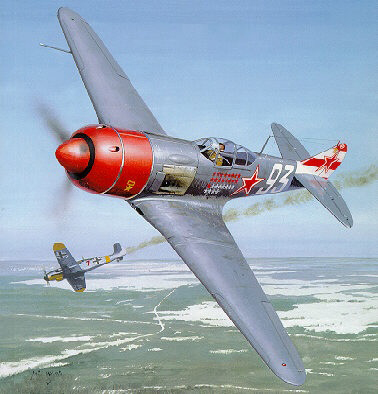
Those Soviet aviators who used to pilot the La-7 considered it to be the best jet fighter. Its speed, maneuverability, powerful gunfire, and reliability as well as battle liveliness allowed the pilots to feel safe and confident in any air combat with a Fascist ace. It was the development and refinement of the Lavochkin LaGG-1 (1939), and the last in a family of aircraft that had begun with the LaGG-13 in 1940. The plane was designed by Semyon Lavochkin, V. Gorbunov and M. Gudkov. For a plane of the 1940’s, LaGG-3 had a maximum speed of 600 km/h (425 mph) which exceeded the speed of German fighter aircraft. However, the construction of the aircraft was heavy and not very airworthy. LaGG was 600 kg heavier than the simultaneously designed Yak-1 and almost a ton heavier than the Messerschmitt – 109E. All this certainly reduced its maneuverability and rate of climb. Even though the Soviet pilots managed to obtain great results with the LaGG’s, they had to resort to various tricks. For instance, K. Grouzdev cut the aircraft turn radius by jetting the landing flaps. The LaGG-3 lost the fights with the Messerschmitts. The improvement was poor and the only solution was to lighten the air-cooled engine. By the end of the year a new La-5 fighter aircraft proved itself in the Stalingrad combat. It was much faster and better-equipped than the Messerschmitt. Two 20-millimeter cannons turned out to be much more efficient than one cannon and two guns on the Fascist planes. The Fighter Wing consisting of ace La-5 pilots only was formed near Stalingrad. Almost all the Fighter Wing pilots became Heroes of the Soviet Union. A new La-5FN jet fighter was tested in the summer of 1943 during the Kursk Bulge battle. Lavochkin lightened the airframe and fitted a more powerful engine. It was superior to the Messerschmitt-109 modifications and the newest Fokke-Wolf-190 in terms of speed, maneuverability and gun power. Nevertheless, it was not enough. In 1943 the designers of the La-5 which had become the mainstay of the Soviet Air Force felt that it could be improved upon. Although preserving the former weight, the designers added one more cannon and increased the speed capacity to up to 680 km/h. The La-7 earned itself a superb combat record by the end of the war, and was flown by the top Soviet aces of the conflict: N. Skomorokhov who personally brought down 46 planes individually and 8 more when flying in a group; K. Evstigneev, who managed 53 enemy aircraft kills. The La-7 was piloted by the Hero of the Soviet Union, Ivan Nikitovich Kozhedub. He shook down 17 hostile aircrafts and ended the war near Berlin. He started his operational record with the La-5FN and brought down all 62 aircrafts with Lavochkin’s jet fighters.
General characteristics of La-7:
Maximum speed: 680 km/h
Takeoff weight: 3265 kg
Service ceiling: 10,750 m
Range: 635 km
Armament: 3x20 mm cannons, 200 kg of bombs
Total production of LaGG aircraft amounted to 6,258; 10,000 of La-5 modifications and 7,753 of La-7 aircraft.
I-16
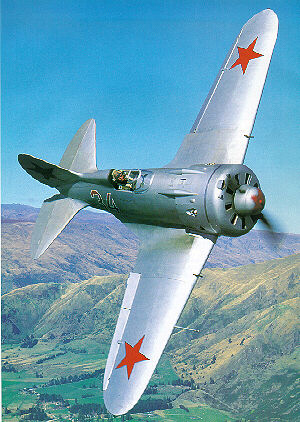
I-16 was designed by Polikarpov and till the early 1940’s has been the backbone of the Soviet Air Force. It was the world's first cantilever-winged monoplane (of wooden construction) fighter with retractable landing gear and torso back protective armour. It was the first fighter aircraft to apply missiles in air fight. In the mid 1930’s this aircraft was considered to be the best in the world. In 1935 it was exhibited at the World Exhibition in Milano where it acquired world-wide recognition. When I-16 first fought with a German Messerschmitt (Me-109B) it turned out I-16 lost in speed; however it was much more maneuverable and better weaponed which caused large enemy’s losses. I-16 acted well in China and Mongolia in 1937-40 in fights against Japanese militarists. At the beginning of the Great Patriotic war I-16 and another main Soviet fighter aircraft I-15 entered the struggle against Fascist air armada. Soviet aircrafts easily wan German bombers (Ju-87 and Ju-88) and He-11. However they lost new Messerschmitt modifications (Me-109E) in almost all tactical and technical characteristics. Soviet pilots managed to attack the enemy at its “tail” only at steep turns. Despite the “obsolescence” of I-16 Soviet aviators managed to fight successfully and win. Thus, on August 7, 1941 protecting Moscow sky Viktor Talalikhin killed a Fascist bomber Heinkel-111 which wrecks are at present time exhibited at the Central Museum of Armed Forces. At some separate parts of the front I-16 still took part in fights up to 1944.
General characteristics of I-16:
Maximum speed: 462 km/h (290mph)
Takeoff weight: 1941 kg
Service ceiling: 9700 m
Range: 700 km
Armament: 2 x 20 mm cannons, 2 fixed forward-firing 7.62 mm (.30 cal) machine guns
Bomb capacity: up to 200 kg
Six RS-82 rockets
Total production: 6,555 I-16 aircraft of various modifications.
Il-2
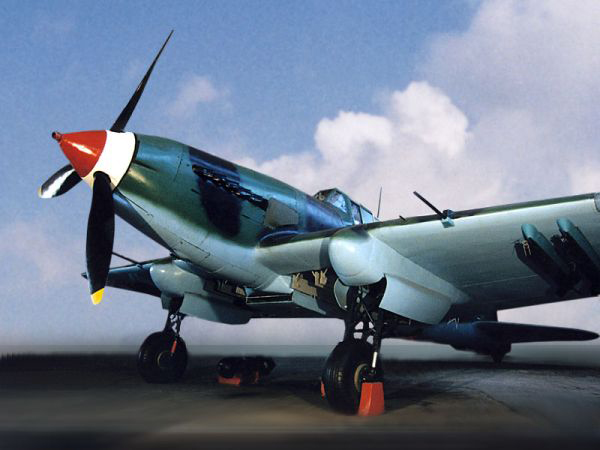
The Ilyushin Il-2 was a ground attack aircraft in the Second World War. The aircraft was armed with powerful rockets and bombs, was very maneuverable and easily piloted. It was an essentially new type of aircraft to attack tanks with high accuracy in dive bombings. It is by right claimed to have been the best ground attack aircraft in WW2. At the beginning of the war the aft quadrant of the Il-2 was left unprotected (there was no radio-gunner), and the aircraft were heavily inferior to the Messerschmitt. Only in the summer of 1942 the Soviet aviation industry launched the production of two-seated Il-2 aircraft. 881 pilots flying the Il-2 obtained the Hero of the USSR rank (27 of them received the honor twice) during the Second World War. Among them were: A. Efimov, M. Odintsov, L. Beda, E. Kungurtsev, V. Adrianov and others.
General characteristics of the Il-2:
Maximum speed: 412 km/h
Takeoff weight: 5873 kg
Range: 765 km
Service ceiling: 5440 m
Crew: 2, pilot and rear gunner
Armament: 2x37 mm cannons; 2x7,62 mm machine guns; 1x12,7 mm manual machine gun; 8xRS-82 rockets
Bomb capacity: 400-600 kg
Total production: 36, 163 Il-2 and 4, 966 Il-10 aircrafts.
DB-3
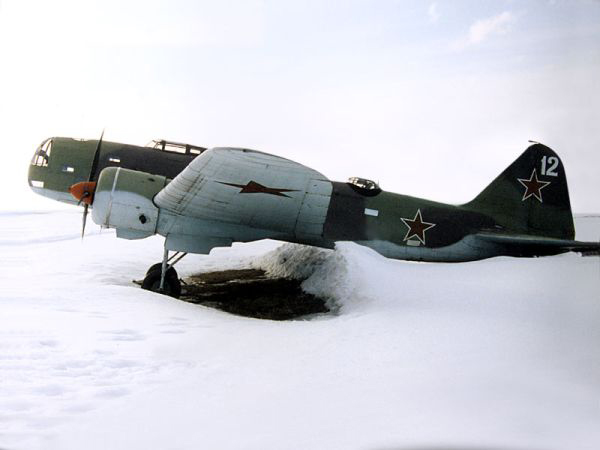
In 1938 the design studio led by S. Ilyushin produced the aircraft called DB-3 (TsKB-30). The test-pilot, V. Kokkinaki, broke several altitude records with various weights on board, and in 1938-1939 he accomplished ultra-long flights from Moscow to Primoriye, and From Moscow to the USA. The militarized Il-4 aircraft type (DB-3F) designed in 1940 was used as a long-range bomber during WW2. Very often it operated in close contact with the ground forces and was used as front-line and tactical air craft. It was also used to stop the invasion of enemy ground troops at any cost. Later the Il-4 was bombing tank and mechanical divisions, artillery, and enemy airdromes.
General characteristics of Il-4:
Engines: 2хМ-88B 1, 100 hp
Wingspan: 21,44 m
Wing area: 66,7 sq.m
Length:14,8 m
Maximum speed: 448 km/h
Takeoff weight: 10,300 kg
Service ceiling: 7,300 m
Range: 4,260 km
Crew: 4
Armament: 1x20 mm cannon, 1x12,7 mm machine gun, 2x7,62 mm machine guns
Bomb capacity: up to 3,000 kg
Total production: 1, 528 DB-3 and 5, 256 Il-4 bombers.
MiG-3
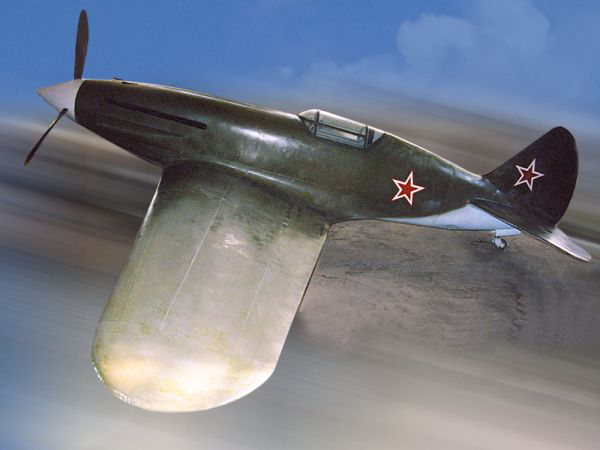
The MiG-3 designed by A. Mikoyan and M. Gurevich was developed from the MiG-1 by the Experimental Design Department of factory No.1. Its development was a crucial improvement for the Russian and world aircraft industry. This was a fine fighter aircraft. Its service ceiling reached 12,000 m. The MiG engine reached a maximum speed of 640 km/h at the altitude range of 7,000 – 10,000 m. The aircraft was superior to most jet fighters in the world, including all German reciprocating engine aircraft. However, the MiG-3 would lose all of its advantages in speed and maneuverability at medium-high elevations. In 1940, however, it wasn’t considered to be a severe disadvantage. Then the designers used to think the air war would be performed at the aircraft’s service ceiling, where it had to intercept the enemy bombers. It turned out that in the areas of direct contact with the ground troops, the air combat was taking place at medium-high altitudes. The German Messerschmitt pilots tried to engage Soviet aircrafts in combat. There the MiGs lost speed being the heavier aircraft (3,3 tons) and lacked maneuverability. Nevertheless, at the beginning of the war the MiGs played an important role in fighting against the superior Luftwaffe forces. The planes formed the famous Fighter Wing 401 commanded by test-pilot S. Saprun, a Hero of the Soviet Union. A. Pokryshkin, the three-time Hero of the Soviet Union, started his military service with the MiG-3. The pilot Nikolai Liskonozhenko managed to down two enemy aircraft during one air combat, and Ivam Goloubin fought thirteen Messerschmitts and shot down two of them. The attempt made by Russian constructors to update the MiG-3 and introduce a new engine failed. By that time two more jet fighters with lighter construction (Yak-9 and La-5) had been produced. That is why the aircraft which had been of advanced design at that time, was abandoned. The time of jet aviation came after the war. The experience gained during the development of the MiG-3 allowed the Soviet designers make the aircraft of this series the mainstay of the Soviet Air Force.
General characteristics of MiG-3:
Service ceiling:12,000 m
Maximum speed: 640 km/h (at the altitude of 7,000 m)
Takeoff weight: 3,350 kg
Range: 1, 250 km
Armament: 1x12,7 mm machine gun and 2x7,62 mm ShKASS machine guns
Total production: 100 MiG-1 and 3,322 MiG-3.
P-39 Airacobra
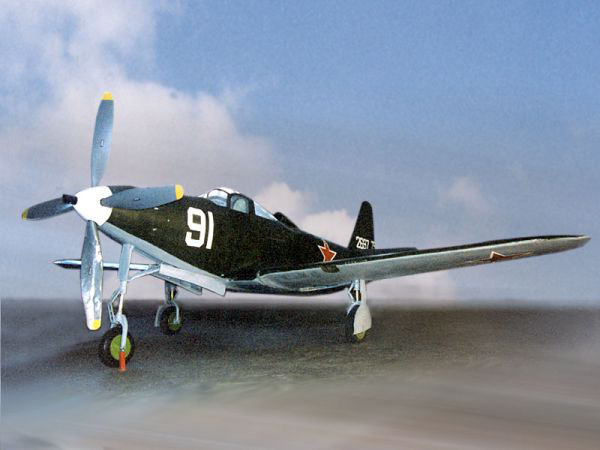
During WW2 the USA as the member of the anti-fascist coalition rendered military assistance to the Soviet Union through land-lease supplies, including military air planes. In mid-1942 the Soviet Air Force was supplied with the R-39 Airacobra fighter aircraft manufactured by Bell. Airocobra (1940) was the principle American aircraft at that time: it was a high-speed, long range craft with powerful armament. Its cabin was very comfortable, well-protected and equipped with a reliable engine. All this made the Airocobra a fine aircraft for supporting the ground troops and for low-altitude air combat. A. Pokryshkin, the three-time Hero of the Soviet Union, was piloting this very aircraft during the war. The German Messerschmitts were superior to Airocobra in terms of maneuverability (just like the heavy Soviet MiG-3 and LaGG-3). It had one more serious disadvantage: it easily fell into a spin and it was difficult to take it out of it. The Soviet command staff informed the suppliers of this. In December 1943 Bell announced the production of a new P-63 King-Cobra fighter aircraft model. By the end of the war the Soviet Union got about 2,400 aircraft which were ferried from America by the Alaska-Siberia route. The King-Cobra was heavier and more powerful than the preceding models. However, the designers didn’t manage to improve the aircraft tendency to go into a spin. In general, by the end of the war, Soviet and German fighter aircraft were superior to the American ones. They were mostly used for air defense against enemy bombers attacking the communication lines and inhabited localities.
General characteristics of King-Cobra:
Maximum speed: 655 km/h
Weight: 4,400 kg
Service ceiling: 11,900 m
Range: 870 km
Armament: 1x37 mm cannon, 2-4x12,7 mm machine guns
Bomb capacity: 227 kg
Pe-2
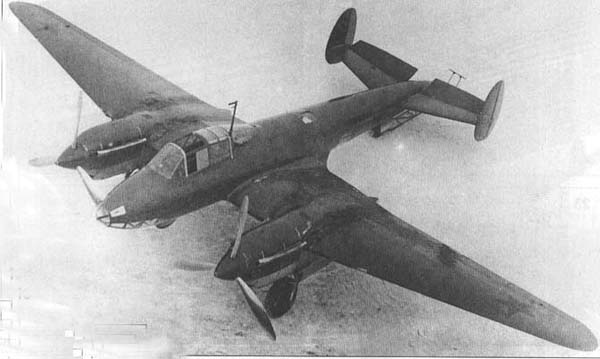
Vladimir Mikhailovich Petlyakov (died in 1942) was the designer of one of the best bombers of WW2, the Pe-8 and Pe-2. The necessity for a Soviet dive bomber aircraft became obvious after analyzing air combat taking place in Spain. There, the Soviet bombers were negated by the modified Messerschmitt aircraft (Me-109E) and, when under fire by Junkers (Ju-87). The VIT and VIT-2 aircraft under design by Polikarpov would not be in production due to a number of factors, the designer’s disfavor being among them. Designing a dive bomber implied profound technical updates: provision of superior structural integrity under G-forces; high lift capacity; maneuverability; high forward flight speed and medium dive acceleration. The aircraft was to be equipped with outside racks to prevent structure damage while bombing. Since the G-force during low dives was high, the aircraft needed to be supplied with an automated device which would let the pilots fly the craft in the horizontal. In 1939-1940 the updates of the two aircraft models were underway: one was being designed on the basis of a SB bomber, the other one as a very advanced high-altitude fighter, the Petlyakov’s '100'. The latter was put under production and comprised the characteristics of a fighter and bomber. Its full-metal structure was able of withstanding heavy G-forces. The aircraft reached the speed of 540 km/h (650 km/h dive speed), performed stunts and dived. From the very beginning of the Great Patriotic War, the Pe-2 showed its true bombing potential. No German bomber could exceed the Pe-2 in speed. Flying the craft wasn’t easy, but the pilots liked it. During the battle of Moscow a prominent pilot, I. Malikov, flew three sorties a day on a Pe-2. After being injured and his leg being amputated, Malikov flew slow-moving aircraft and some time later he returned to the Pe-2, his favorite “peshka” (pawn). Another Soviet pilot, I. Polbin, worked out the most effective continuous group dive-bombing attack. Several Pe-2 bottled the enemy aircraft up and then dived to the target one after another keeping a 500-600 m distance. On noticing the enemy bombers, the Pe-2 started attacking. Accelerating the speed they cut behind the enemy crafts like jet fighters, opened fire and won. “It is not a craft, it’s a miracle”, Polbin used to say. And his crew would joke: “We queen our “pawn”. It can checkmate any king…”. The Pe-2 fighting abilities haven’t gone unnoticed. The Pe-3 variant, the escort fighter, was fighting in the North. The 125 female guard bomber wing formed by the two times Hero of the USSR, M. Raskova, was flying the Pe-2 as well.
General characteristics of Pe-2:
Powerplant: 2хVK-105RFx1250 hp
Wingspan: 17,16 m
Wing area: 40,5 sq.m
Length: 12,66 m
Takeoff weight: 8, 250 kg
Maximum speed: 540 km/h
Service ceiling: 8,800 m
Range: 1, 500 Kм
Crew: Three - pilot, gunner, bombardier
Armament: 3x12,7 mm machine guns, 2x7,62 mm machine guns
Bomb capacity: 600 kg
Total production: 11,427.
SB (ANT-40)
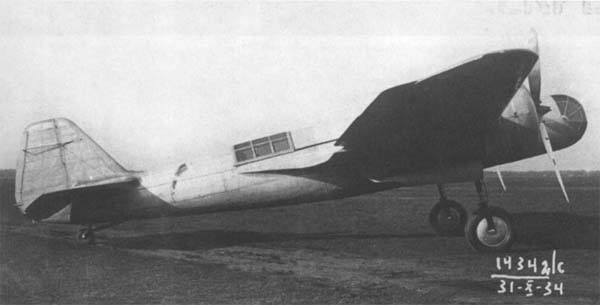
The SB (ANT-40) was designed in 1934 at A. N. Tupolev’s construction bureau. The craft was designed as a high-speed monoplane bomber to act together with ground troops and the fleet. As far as such bombers were not always capable of escorting ground troops, they had to be equipped with the necessary defense armament and have high speed. Tupolev delegated the project development to A. Arkhangelsky, which managed to increase the aircraft speed to up to 420 km/h instead of the expected 325 km/h. SB successfully fought in Spain, China, Mongolia, and Finland. In Spain it was the mainstay of the Republican Air Force. Having covered about 800 km, on February 23, 1938, a group of SB aircraft attacked the Japanese military base in Taiwan. The aircraft bomb capacity was over 1000 kg. As it turned out, Arkhangelsky designed a safe and endurable craft. Even at the beginning of the 1940’s, no German bomber could match the aircraft for speed (except for the latest Junker-88 variant). The craft was exceeded in range and bomb capacity only. SB successfully negated the attacks of German fighters. Even though in some cases its speed was not enough to elude pursuit, it was difficult to bring the Soviet bomber down. Four machine guns were protecting it on every side. However, the SB had never been the mainstay of the Soviet Air Force. It was used at the opening stage of the war, during the Moscow battle, for instance; and it was completely replaced by the more powerful Pe-8 and Il-4 bombers. Perhaps, one of the reasons for the SB being abandoned was that its shadowgraph and engine drone resembled that of the Junker-88. Therefore, it was often taken for a German bomber and brought down despite the red stars on its wings and tail.
General characteristics of SB:
Powerplant: 2хМ-100А (860 hp) or 2хМ-103 (960 hp)
Wingspan: 20,33 m
Wing area: 52 sq. m
Length: 12,72 m
Maximum speed: 424 km/h (450 km/h)
Takeoff weight: 5,700 kg
Service ceiling: 9,000 m
Loaded range: 1,000 km
Armament: 2-4 machine guns
Bomb capacity: up to 1,000 kg
Total production: 6,656 SB crafts.
Po-2
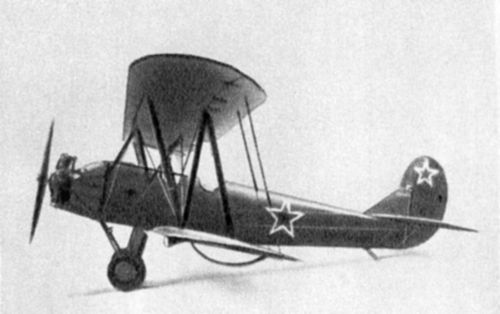
“Russe Vaner” was the first humiliating nickname for the Soviet biplane. “Celestial slow-mover” called it the Soviet soldiers. The crew of N. Polikarpov designed Po-2 in 1927. Before the war the craft served as a trainer. Thousands of youngsters took up their maiden flights on a Po-2. At the beginning of the war, due to severe Soviet aircraft losses the Po-2 served extensively as a liaison and general supply aircraft. It was especially useful for delivering the commands and dispatches, for photographing the enemy locations, troop, and machine movements. However, these reliable, uncomplicated and forgiving crafts were adapted to be light night ground attack planes. Initially, the military pilots felt rather skeptic about Po-2 and nicknamed it “kukuruznik” (from Russian “kukuruza” for maize) and “veneer shells”. And yet, the slow-movers turned out to be capable of destroying the pinpoint targets which were inaccessible for high-speed dive bombers. Every night they took 150-200 kg bombs aboard and attacked the bunkers, headquarters, and master stations, enemy troops and machines. The Luftwaffe command staff was aware of the Po-2’s “abilities” and set to the task of eliminating them. German aces were awarded with Iron Crosses for every Po-2 brought down. Thereby, the little Po-2 was often “between Scylla and Charybdis”. From above it was attacked by Messerschmitts, and by all kinds of guns from below. The Soviet pilots realized that very soon and used the tactic of flying at treetop level. Thus they could creep into enemy positions and leave unnoticed. Their usual tactics involved flying only a 1, 500 meters above the ground, rising for the final approach, cutting off the engine and making a gliding bombing run. The bomb impact was absolute. However, after the attack low speed turned out to be a severe defect: the Po-2 took fire easily. Po-2 pilots commonly “burned above the target”. To enlarge the bomb capacity of the craft, the pilots reduced the fuel reserve to a minimum and kept their own weight trim. The Po-2 is known as the plane used by the regiment of all-women pilots and ground crew. 23 women pilots of the crew earned the Hero of the Soviet Union citation. The pilots of the 46th Guard Bomber Regiment earned the nickname “Night Witches”.
General characteristics of Po-2:
Maximum speed: 145 km/h
Flight weight: 1, 350 kg
Armament: 1xShKASS machine gun
Bomb capacity: 200 kg
Total production: 40,000
Yak-9
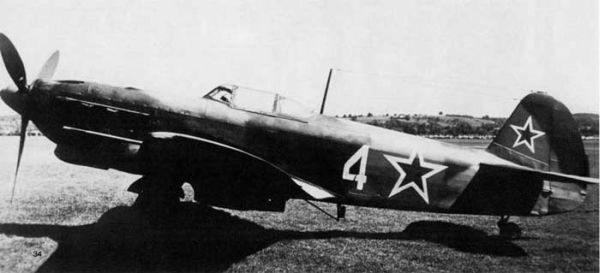
The Yak-9 was the most produced Soviet fighter of the war. The Yak-9 remained in production from 1942 to 1948 with almost 17,000 built. The Yak-9 is a craft produced by the famous Yakovlev KB (design bureau). The first in the sequence of aircrafts was Yak-1. It saw production alongside with the aircraft of other designers: LaGG-3 and MiG-3. Yak-1 was lighter, more maneuverable and had the best rate of climb. Its high speed (580 km/h) made the aircraft a hands-down winner as compared to the outdated I-15 and I-16. Thus, the Yak-1 was a worthy opponent to the German Messerschmitts. It is known as the best Soviet fighter of the beginning period of the war. The Yak-7 designed in 1941 was a development of the two-seat Yak-1. The Yak-7 was equipped with a covered reservoir and used for cargo transportation with an extra fuel tank which extended the Yak-7 range considerably. The Red Army needed such planes badly for covering operations with no bomber or fighter support. The Yak-9 was the next aircraft development. This model saw production in 1942. Alongside with the La-5, they fought in the Stalingrad battle and in fights for air control. The Yak-9 had a significant advantage over the Messerschmitt-109G-2 and even the Fokke-Wolf-190A3 at medium altitude. The Soviet designers managed to make the plane lighter and more spacious by switching from wood to dur-aluminium. This allowed equipping the plane wings with large-volume fuel tanks. This is how the Yak-9D and Yak-9DD (1943) were designed. Their flight range was 1,330 and 2,200 km which exceeded three times the range of common fighters. The Yak-9 was better armed as well: for instance, the Yak-9K was equipped with 37 mm machine guns which were changed for 45 mm guns in 1944. The bombs could break tank armor and enemy planes were destroyed at the first impact. The Yak-9U (fighters of enhanced structure) maintained air control during the concluding period of the war. Here is historic evidence: on April 17, 1945 near the town of Zeelov, Soviet aircraft destroyed 16 enemy planes sustaining no losses of their own. The Yak-3 was one more development among the many successful Yakovlev’s fighters. It was designed in 1943 based on the battle experienced Yak-1 and included the innovations of the Yak-9. As one of the smallest and lightest top speed (720 km/h) major combat fighters, its high power-to-weight ratio gave it excellent performance. The Yak-3 is regarded as one of the best fighters of WW2. The French pilots from the famous Normandie-Nieman fighter squadron preferred the Yak-3 to American and English fighters.
General characteristics of Yak-9U:
Maximum speed: 700 km/h
Flight weight: 3,150 kg
Service ceiling: 11,000 m
Range: 950 km
Armament: 1x37 mm cannon, 2x12,7 mm machine guns
Total production: 8,721 Yak-1, 6,339 Yak-7, 16,769 Yak-9 of all variants, and 4,848 Yak-3.
|










